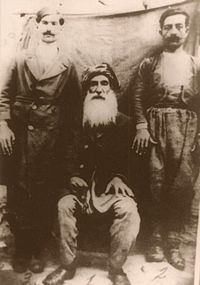Seyid Riza
[6] Riza was born in Lirtik, a village in the Ovacık district, as the youngest of four sons of Seyid Ibrahim, leader of the Hesenan tribe.
[9] During the Newroz festivities of March 1937, Seyid Riza called for a rebellion against the Turkish government.
The final sentence was passed on a Saturday, a highly unusual day for a court to be in session at that time.
This abnormal course of events was due to Mustafa Atatürk's impending visit to the region and the local government's fear that the Turkish head of state would be petitioned to grant Riza amnesty.
[11] The chief judge of the court at first refused to render his final verdict on a Saturday, citing a lack of electricity at night and the absence of a hangman.
After local authorities arranged to light the courtroom with automobile headlights and found a hangman, everything was set for the passing of the sentence.
[12] Seyid Riza was 74 years old when the sentence was announced making him legally ineligible to be executed by hanging.
His final moments were witnessed by İhsan Sabri Çağlayangil: 'Seyid Riza understood the situation immediately when he saw the gallows.
A document, submitted to the Presidency with the signature of Minister of Interior Şükrü Kaya on 18 October 1937, states that this letter was in fact written, and signed, by a person named Yusuf in Syria.
[15] It is indeed very likely that this letter was not sent by Seyid Riza but by Nuri Dersimi, a Kurdish nationalist revolutionary from Dersim who took refuge in Syria.
The letter was written in a failed attempt to get support for the Kurdish nationalist cause from Western powers.
[17] During a visit to Tunceli, president Abdullah Gül was asked to disclose the location of the grave where Seyid Riza and his companions were laid to rest after their execution.
said Hüseyin Aygün a lawmaker from Dersim/Tunceli, representing the province in Turkish parliament for opposition party CHP.
